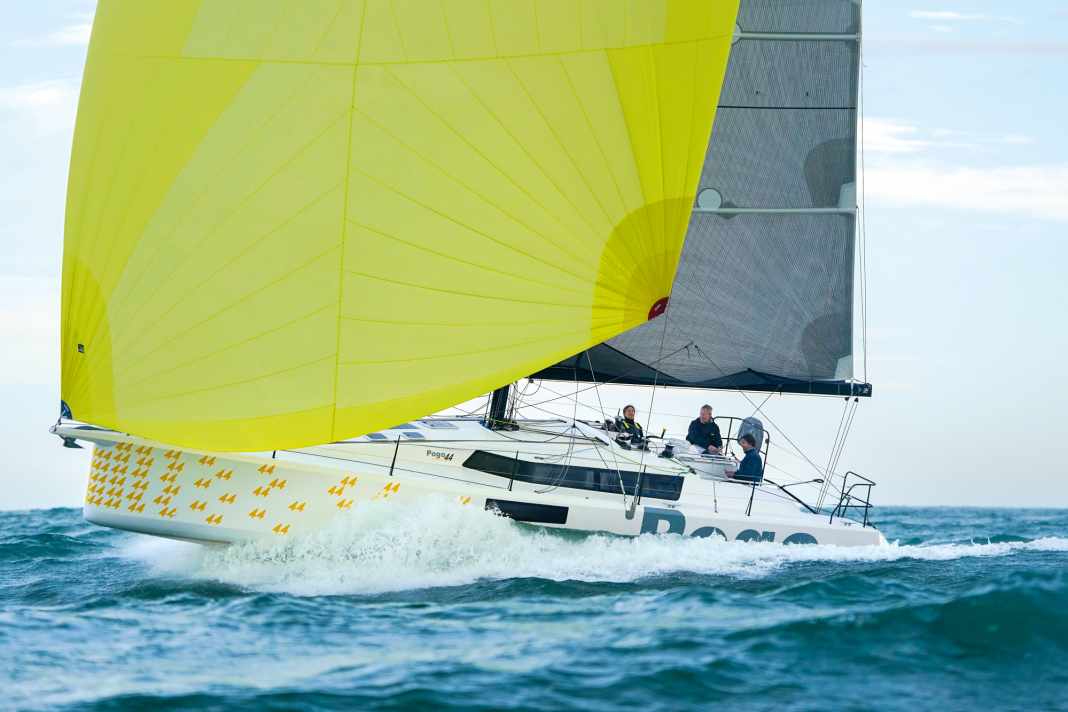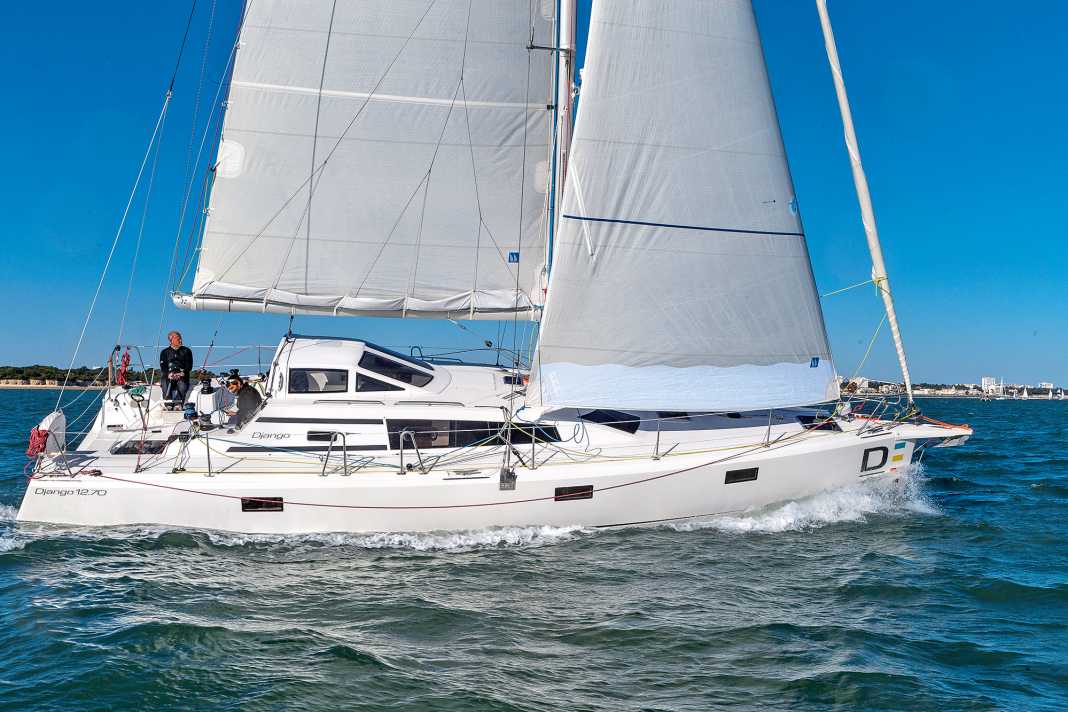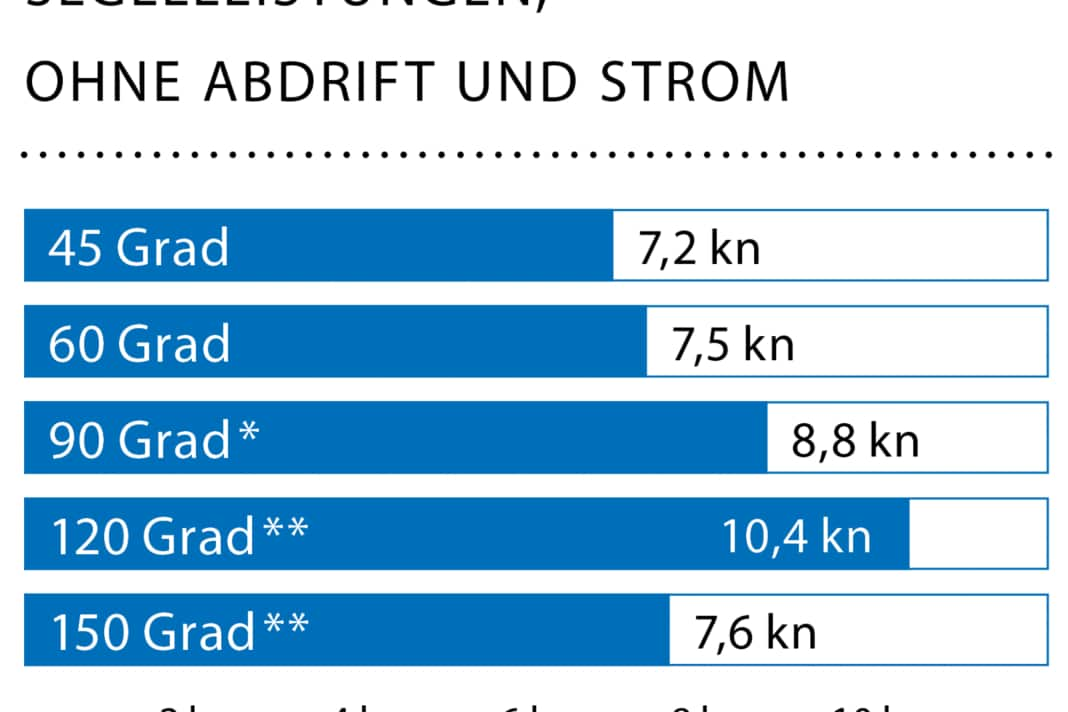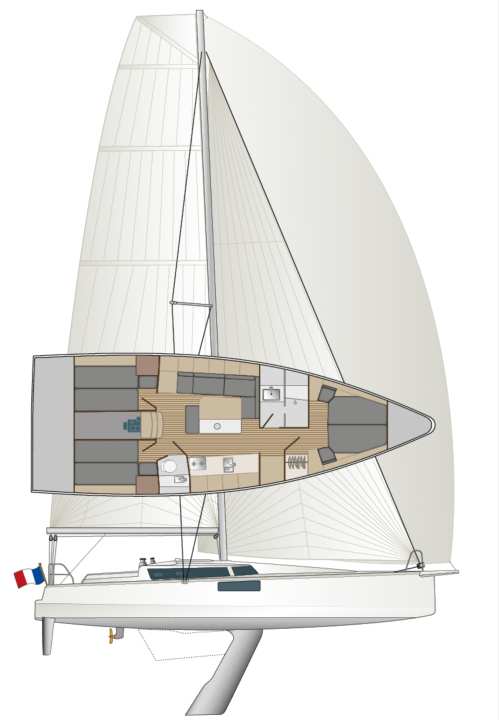





Only power helps in the long run
Some brands stand for a specific niche like few others; they are representative of an entire type of ship. For example: Hallberg-Rassy is indisputably the benchmark for upmarket blue water sailing. In the same way, X-Yachts is exemplary for performance cruising, and Brenta has almost become a symbolic trademark for modern day sailing. And the themes of offshore racing and fast cruising have a very popular figurehead in the form of the Pogo brand.
The Pogo Structures shipyard from Brittany has been in existence since 1987 under the management of founder and owner Christian Bouroullec. The company in Combrit on the French west coast has become well-known and important in particular for its boats for the Mini 6.50 class, which have been setting the standards for fast offshore dwarfs for years under the name Pogo 1, 2 and 3, and are now in their third model generation. The small offshore racers, which are still produced in considerable numbers, essentially cover the French company's bread and butter business.
Over the years, Pogo has also built up a notable programme of fast cruisers, also known as crossover boats, which are also suitable for the high seas. The line starts with the nine-metre-long Pogo 30 (test in YACHT 14/ 2013) and extends to the large 50 with a hull length of over 15 metres. In between, the Bretons have continued to fill out the range. The Pogo 36 was introduced in 2016 (test in YACHT 1/2017) and the Pogo 44, which is conceptually very similar to its little sister, but two metres longer and 50 centimetres wider. In the medium term, it will probably replace the Pogo 12.50, which has been on the market for over ten years.
Revised and tightened design features
The current pogos from the "Croisière" range, i.e. the cruising types, all come from the Finot/Conq design office with a largely standardised signature. In other words: hulls with a pronounced uphaul and extremely wide sterns, double rudder system with two tiller posts in the cockpit as well as a powerful rig positioned far aft with an enormous sail area. In addition, all pogos are equipped with a swivelling keel.
For the 44, designer Pascal Conq has once again significantly tightened up the features. This means that the pronounced chines are angled even more strongly aft, resulting in a widely drawn-in waterline and laterally long hull overhangs - but only in a neutral swimming position. Even with little heel, the underwater hull dips downwind across the beam to the chine, which provides a lot of lift and extremely high dimensional stability; this means that more sail area can remain set for longer. Added to this is the strong righting force generated by the swing keel with its immense draught of 3.10 metres and a very low centre of gravity.
The leading edges extend far forward, where they ultimately end in a very full front section, a kind of semi-scow bow. With the distinctly wide but flat nose and the high forefoot, the Pogo is designed to glide over the waves instead of breaking through them. The additional volume in the foredeck also helps the boat to dip less over the bow when there is a lot of pressure and heeling, making it more balanced, stiffer and ultimately faster to sail, especially in swell.
IMOCA as a model for the Pogo 44
The rather radical design language of the Pogo 44 may be polarising, but it more or less corresponds to the latest findings in the design of modern ocean racers. The latest designs of the excitingly innovative Imoca 60 class, for example, with their hull shapes optimised for long strokes on the beam, were clearly the inspiration for the development of the Pogo 44.
In the small harbour of the picturesque town of Sainte-Marine in Brittany, not far from the shipyard, the Pogo 44 stands out from the large mass of small and rather inconspicuous boats. With its impressive dimensions, especially at the stern, the imposing sailing machine appears larger than it actually is. After all, the stern is 4.50 metres wide, which is the largest projection ever. This is not necessarily an advantage when manoeuvring in the harbour and when parking in the box.
Light and strong: vacuum infusion process



The maxim at Pogo is: consistent weight reduction. All parts are built using the vacuum infusion process
When you enter the Pogo Structures shipyard, one thing is immediately noticeable: It doesn't smell as strongly of polyester and styrene as is often the case in such companies. This is because Pogo consistently manufactures all GRP parts using the vacuum infusion process, including the canting keel, but not as a sandwich but as a thick solid laminate. How exactly this is done in detail remains a well-kept secret at Pogo. The lowest part of the comparatively light GRP keel shaft is inserted into a lead body, the actual ballast section, and is bolted to it. This means that around 1.95 tonnes of the 2.1 tonne keel (approx. 92 percent) is installed at the maximum draught, i.e. between 2.00 and 3.10 metres.
Really let it rip
As ordered in advance, the Atlantic offers perfect conditions for the YACHT test. The south-westerly wind blows at between 15 and 20 knots and pushes a nice, long swell in front of it. On a boat like the Pogo 44, you can look forward to fast courses under gennaker in these conditions. But before we get that far, we first have to head far in the opposite direction. The log shows an average of 7.2 knots on the long cross. The boat tacked over 90 degrees, which is quite a lot for a performance-orientated racer. On top of that, the flat hull with the full front sometimes hammers quite hard into the approaching waves. Cruising is not necessarily the Pogo 44's favourite discipline in wind and waves.
On the other hand, the boat benefits from its enormous dimensional stability and a lot of righting moment when sailing upwind. The Pogo sails remarkably stiff and upright and can easily cope with gusts without having to constantly trim the sails. On long sea voyages, the high stability under sail is generally a great advantage, especially for more comfort on board.
For the way back, a gennaker with 165 square metres in the stocking is pulled right up to the masthead. Then it's time: Hold on tight! The Pogo 44 accelerates like a small planing dinghy, firing away as if she had a harbour urge. The log quickly shows double-digit values and the plump bow comes up. The ship, which is just under 13 metres long, is easy and relaxed to steer through and over the waves, responding immediately to the steering impulses on the tiller steering. The log registers 14.3 knots at full planing speed as the daily record during the YACHT test, and the people at Pogo report speeds of up to 18 knots as the best performance in even more wind. These are impressive figures!
The autopilot is part of the Pogo 44
The layout in the cockpit is characterised by a clear division into two sections. All halyards, sheets and trim lines are operated at the front, directly at the companionway. And there are quite a few of them. For a total of 18 functions (including mainsail and headsail sheets), there are four large winches to the left and right of the companionway, which the crew can operate very efficiently while standing at a good height. Two of these are also available with electric drives on request. The distance between the drums and the stoppers is also large enough so that all lines can be run over one winch or the other as required. In this way, the functions do not jam during manoeuvres. Overall, the layout in the front cockpit is rather unusual, but proves to be very functional and practical - a good solution.
The helmsman sits at the very back on the side of the running deck or further forward, more comfortably and protected on the cockpit bulwark. From both positions, he has a good grip on the nearby tiller, with or without the outrigger. Apart from steering, however, he doesn't have much to do there. Only the trim line for the traveller - particularly important in this rig concept - is within his direct reach. The helmsman has no access to any other functions on the companionway from his position.
The competition: fast ships for long strokes





If you want to sail the Pogo 44 with a small crew, double-handed or single-handed, you will inevitably have to have a good and reliable autopilot installed. This is undoubtedly part of the concept and should actually be part of the standard scope of delivery. Pogo Structures would also be able to build the new 44 with two steering wheels instead of two tiller wheels.
The rig is positioned unusually far aft, almost exactly in the centre of the hull length. This means that the genoa (called a solent by the French), which overlaps only briefly, is proportionally larger than with conventional rig concepts. In addition, there is a fully battened mainsail with a widely flared head section (square or fathead). Because the mast, with its very long and strongly angled spreaders, does not need back and leech stays, the sailmaker has more freedom for the mainsail in terms of luffing and leech delivery.
Worthwhile surcharges
The Pogo 44 comes with an aluminium mast and boom as standard from the shipyard. A carbon fibre rig is available for an additional charge. For a ship as powerful as the Pogo 44, this additional investment is definitely worth it - not only because the carbon mast with rod shrouds is lighter, but also because it is significantly stiffer than the aluminium profile. This is essential for this particular rigging plan without a backstay, because the tension on the shrouds has to be extremely high and the loads are therefore considerable.
Even for the simple sail set with main and solent, the buyer has to factor in considerable additional costs on top of the basic price, depending on the quality and design. In any case, the Pogo concept makes little sense without a gennaker and (or) Code Zero. Unfortunately, these sails are not available for free either. In addition, a smaller staysail as a jib, a so-called trinquette, is essential for long strokes.
Storage space for sails is limited
At least one additional sail, for example the gennaker in the recovery tube, can be stored in the forepeak, where the anchor chain is also stored in a separate area. However, the storage space here is quickly exhausted and the hatch is too small for larger sail bags anyway. A little more space is available in the aft peak, although care must be taken to ensure that stowage items such as sails, fenders or mooring lines do not become entangled with the steering mechanism, which runs completely unprotected below deck with push rods. Unfortunately, there are no additional stowage spaces such as forecastle boxes below the cockpit thwarts.
A separate storage compartment for the life raft is integrated in the rear. However, the rescue box would be difficult to reach if required because the flap opens upwards and blocks access. It would be better to have an attached flap without hinges, which could be removed quickly and completely in an emergency.
Plenty of space in the cabins of the Pogo 44
The Pogo 44 also benefits from its extraordinarily voluminous hull for the interior below deck. Due to the large width aft, the berths there can be rectangular, which is comfortable for two people to sleep in. The space available in the foredeck is also above average, and the dimensions for the owner's double bed are well above the standard dimensions for this size of boat. In addition, the sofa berth in the saloon can be converted into an additional double bed thanks to the lowerable table. Eight people can therefore easily spend the night on the Pogo 44. Two bathrooms are provided for this purpose.
Pogo offers alternatives for the foredeck, where two cabins can also be installed. However, judging by the plans, the berths are then quite narrow and only suitable for single occupancy. There is also some variation for the forward toilet room. Instead of the separate shower compartment, a locker for wet oilskins could be installed there.
Interior design is simple, but not uncomfortable
The interior is kept simple and very straightforward throughout, but impresses with a high level of functionality and yet a surprising amount of comfort. The galley, which is integrated into the saloon as a long row on the starboard side, has large work surfaces and plenty of usable storage space. The large windows in the superstructure and hull create a feeling of an open and bright living environment, allowing views both standing and sitting. Currently very much in vogue on French boats: the windows in the forward tapered cabin superstructure also allow you to see in the direction of travel and even into the sails to some extent.
In line with Pogo's concept philosophy, the shipyard has also placed great emphasis on maximising weight savings for the interior fittings. Wherever possible, the French have used featherweight yet robust composite parts instead of heavier plywood components. The cabins are only separated by curtains instead of doors, although these are available as an option. And the shipyard does not use heavy inner shells, neither in the saloon nor in the cabins. Instead, the underside of the originally quite rough infusion deck is sanded and levelled until the surfaces are absolutely perfect.
Not for beginners
The concept of the Pogo 44 is able to deliver good compromises and builds bridges between many different requirements. Fast and successful regatta sailing or sporty sailing with the family - both are possible. At the same time, it is a demanding and rather complicated boat to sail. A certain level of basic sailing ability is an absolute prerequisite. Not for beginners, therefore, but rather something for active and ambitious people. Boredom on long trips? Definitely not with this boat!
The measured values for testing the Pogo 44




The Pogo 44 in detail

Technical data of the Pogo 44
- Designer: Finot/Conq
- CE design category: A
- Torso length: 12,80 m
- Width: 4,50 m
- Draught (swivelling keel): 1,38-3,10 m
- Weight: 5,9 t
- Ballast/proportion: 2,1 t/36 %
- Mainsail: 63,0 m2
- Genoa (105 %): 50,0 m2
- machine (Volvo Penta): 29 kW/40 hp
Hull and deck construction
GRP sandwich with foam core, built using the vacuum infusion process. Vinyl ester resin outside, polyester inside
Price and shipyard
- Price ex shipyard: 394,485 € gross
- Guarantee/against osmosis: 5/5 years
- Shipyard and distribution: SAS Pogo Structures, 29120 Combrit (France); www.pogostructures.com
YACHT review of the Pogo 44
Ultimate and demanding fast cruiser for fast and sporty passages. The design goes to extremes, which is visually polarising, but should suit a certain clientele. Cosy inside
Design and concept
- + Compromising concept
- + Competitive base price
- + Robust construction, yet lightweight
Sailing performance and trim
- + Extremely high performance potential
- + Fast reactions on the beam
- - Complicated handling
Living and finishing quality
- + Simple, no-frills interior design
- + Large pantry with plenty of storage space
- - Very small navigation
Equipment and technology
- + High-quality deck equipment
- - Autopilot only as an expensive extra
The article first appeared in YACHT 17/2021 and has been updated for this online version.

